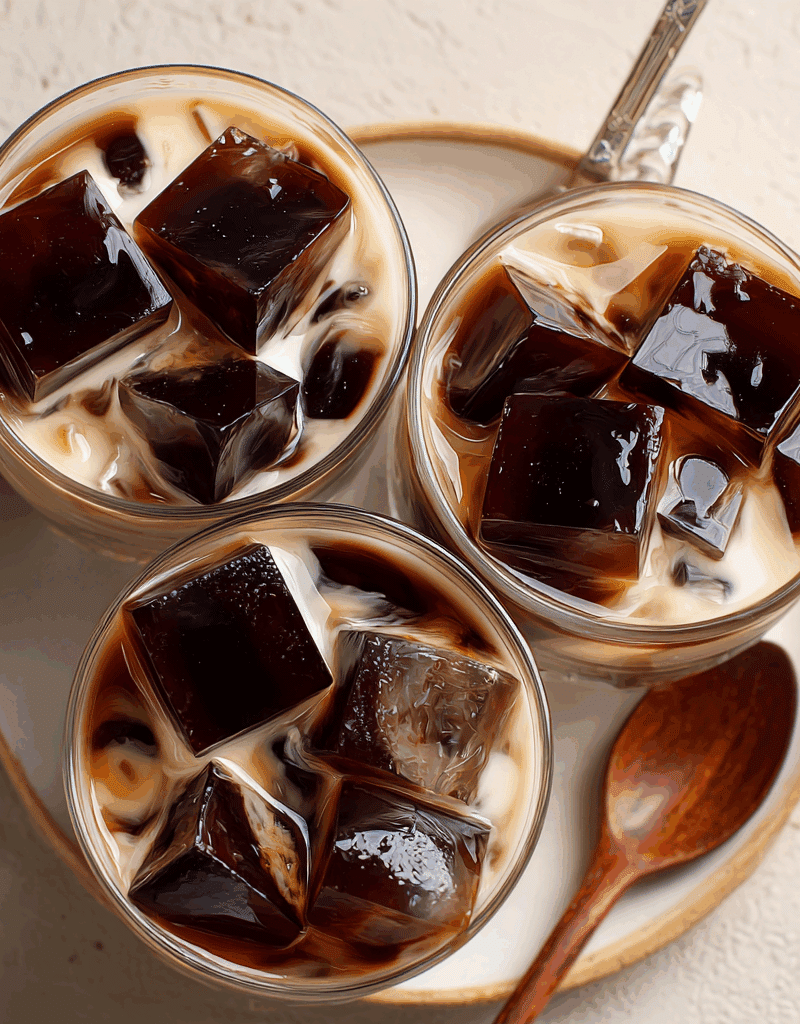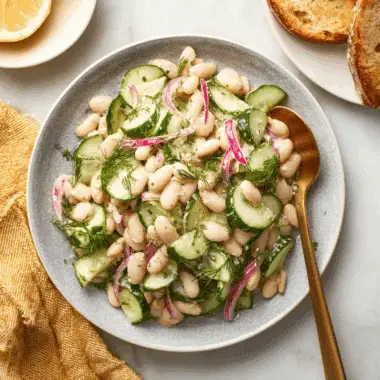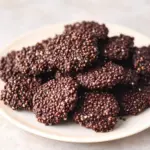The beloved coffee jelly dessert is a creamy-meets-caffeinated experience that combines firm cubes of smooth coffee gelatin with the richness of chilled milk or cream. With its cool, silky texture and satisfying coffee flavor, it’s a favorite for both dessert lovers and caffeine enthusiasts alike.
Perfect for warm days or a light afternoon treat, this no-fuss recipe comes together quickly and looks stunning in individual glasses. The deep brown jelly contrasted with creamy white milk makes a visually delightful and refreshing finale to any meal. Whether you’re serving it at a family gathering or indulging in a solo sweet moment, this coffee jelly is bound to impress.
Full Recipe
Ingredients:
-
2 tablespoons instant coffee
-
2 tablespoons sugar
-
2 cups water
-
2 tablespoons unflavored gelatin powder
-
1/4 cup hot water (to dissolve gelatin)
-
1 cup chilled evaporated milk (or cream of choice)
-
Ice cubes (optional for serving)
Directions:
-
In a saucepan, combine 2 cups of water, instant coffee, and sugar. Bring to a gentle boil until the sugar and coffee granules are fully dissolved. Remove from heat.
-
In a small bowl, dissolve gelatin powder in 1/4 cup hot water. Stir until fully dissolved.
-
Add the dissolved gelatin into the hot coffee mixture. Stir well to combine.
-
Pour the mixture into a rectangular or square container. Let it cool to room temperature, then refrigerate for 2-4 hours, or until fully set.
-
Once set, cut the coffee jelly into small cubes.
-
To serve, place jelly cubes into individual serving glasses or bowls. Pour chilled evaporated milk over the jelly. Add ice cubes if desired.
Prep Time: 10 minutes | Cooking Time: 5 minutes | Total Time: 15 minutes (plus chilling time)
Kcal: 120 kcal | Servings: 4 servings
The Sweet Revival of Coffee Jelly
Coffee jelly is a beloved dessert that originated in Japan and gained popularity in other parts of Asia, especially in the Philippines. With its uniquely rich coffee flavor balanced by a soft, jiggly texture, coffee jelly offers a sensory experience that bridges the gap between dessert and beverage. The contrast of slightly bitter coffee and creamy milk makes it a refreshing treat—especially during warmer months.
Despite its minimal ingredients and simple preparation, this dish has a way of delighting both children and adults alike. Whether served at gatherings, cafés, or enjoyed solo as a cooling snack, coffee jelly is an affordable, nostalgic, and deeply satisfying dessert.
A Brief History of Coffee Jelly
The origins of coffee jelly trace back to early 20th-century Japan, where Western influences began merging with local culinary traditions. Inspired by European gelatin desserts, Japanese chefs created a coffee-flavored version to appeal to a younger, modern audience. Over time, the dessert spread throughout East and Southeast Asia, evolving with regional twists.
In the Philippines, coffee jelly rose to popularity in the early 2000s, frequently featured in home parties, holiday celebrations, and buffet spreads. Filipino home cooks appreciated how accessible and budget-friendly it was to make, using common pantry ingredients like instant coffee and evaporated milk. Its aesthetic appeal, served in clear cups or glass bowls, also made it a photogenic and crowd-pleasing addition to any dessert table.
Why Coffee Jelly is the Perfect Summer Dessert
Coffee jelly’s biggest appeal lies in its refreshing quality. Chilled, light, and mildly sweet, it’s the ideal end to a rich or savory meal. Served over ice or paired with evaporated milk, cream, or condensed milk, the jelly cools your palate while offering that familiar kick of coffee.
It also caters to those who love caffeine but want a low-calorie or less intense way to enjoy it. Unlike a hot coffee drink or rich dessert like tiramisu, coffee jelly is delicate and gentle—perfect for warm climates and afternoon tea breaks.
Its versatility also allows for countless customizations. You can use strong brewed coffee, espresso, or flavored variants like vanilla or hazelnut. It pairs beautifully with other add-ins like tapioca pearls, crushed graham crackers, or even a scoop of vanilla ice cream.
Cultural Significance and Popularity
In Japan, coffee jelly is often served in cafes with whipped cream or as a topping for parfaits. In the Philippines, it’s a popular potluck item, often layered with sweetened cream mixtures or turned into a trifle-style dessert in large containers. Its texture and appearance evoke nostalgia and comfort, especially for those who grew up seeing it at family gatherings.
As Asian desserts become more popular globally—thanks to TikTok, YouTube, and food bloggers—coffee jelly is now finding its way into Western kitchens. Its easy preparation and minimal equipment needs make it a hit among beginner cooks, students, and even kids learning to make simple desserts.
The Science of Coffee Jelly: Why It Works
The success of coffee jelly lies in the balance of its components: strong coffee provides the bold, aromatic base, while gelatin gives it the signature wobble. When mixed properly, gelatin traps water molecules and sets into a smooth, firm yet tender structure.
The addition of cream or milk adds fat, which balances the bitterness of the coffee and adds richness to the experience. Depending on your preference, the dessert can lean toward bittersweet sophistication or indulgent sweetness.
Understanding this balance allows cooks to tweak the dish—less sugar for a stronger coffee bite, more milk for a mellow flavor, or firmer jelly for a boba-style drink component.
Modern Twists on a Classic Treat
One of the fun aspects of coffee jelly is how easy it is to modernize. Home cooks and chefs have come up with creative ways to adapt it to current trends and taste profiles.
-
Vegan Coffee Jelly: Using agar-agar instead of gelatin makes the recipe fully plant-based. Pairing it with coconut cream or oat milk adds a unique twist.
-
Iced Coffee Jelly Drinks: Combine jelly cubes with iced lattes or cold brew for a textural surprise in your beverage—similar to bubble tea.
-
Layered Coffee Jelly Parfaits: Alternate layers of jelly, cream, and crushed cookies in clear cups to make an eye-catching dessert.
-
Espresso Martini Jelly Shots: Add a splash of coffee liqueur and serve in mini glasses for an adult-friendly party treat.
The possibilities are endless, and the base recipe serves as a blank canvas for your creativity.
Presentation Tips for Serving Coffee Jelly
Presentation plays a huge role in elevating simple desserts. Coffee jelly can be served in a variety of ways:
-
Clear glasses or jars allow the beautiful contrast between the dark jelly and light milk to shine through.
-
Layered dessert bowls work well for parties, where guests can scoop out their preferred amount.
-
Shot glasses or mini bowls are perfect for portion-controlled treats or tasting menus.
Garnish ideas include whipped cream, cocoa powder, chocolate shavings, or a sprinkle of cinnamon for that café-style flair.
Pairing Suggestions and Occasions
Coffee jelly is remarkably versatile and fits a wide range of occasions. Serve it:
-
As a refreshing dessert after heavy meals like pasta, curry, or grilled meat.
-
At brunch tables, alongside fruit and pastries.
-
For afternoon snacks, especially when served with biscuits or tea.
-
At picnics or potlucks, stored in portable containers and kept cold.
-
In school lunchboxes for a treat kids will look forward to.
As for pairings, consider serving it alongside almond biscotti, vanilla cake, or even savory snacks like cheese crackers to contrast with the sweet notes.
Storage and Shelf Life
Coffee jelly is best stored in an airtight container in the refrigerator. It keeps well for up to 5 days, making it a great make-ahead option. The texture may become slightly firmer over time, but it will still be delicious.
If you’re preparing it in advance for a gathering, cube the jelly and store it separately from the milk or cream topping to maintain the best texture. Only combine the two when you’re ready to serve.
Health and Dietary Considerations
Coffee jelly can be adapted to suit a variety of dietary needs:
-
Low Sugar: Reduce the amount of sugar or use alternatives like stevia or monk fruit.
-
Dairy-Free: Use almond, soy, oat, or coconut milk instead of evaporated or condensed milk.
-
Gluten-Free: Naturally gluten-free as long as your flavorings and milk alternatives are too.
-
Low-Calorie: Use unsweetened black coffee and a splash of skim milk or a non-dairy milk with no added sugar.
It’s a satisfying treat that doesn’t feel heavy or guilt-inducing—perfect for those watching their intake but still craving something sweet.
Conclusion
Coffee jelly is more than just a dessert—it’s a comforting tradition, a nostalgic favorite, and a blank canvas for culinary creativity. Whether you’re reliving childhood memories or exploring new food trends, this chilled treat offers simplicity, flavor, and elegance in every spoonful.
Its minimal ingredients and flexible nature make it a go-to recipe for home cooks of all levels. With the growing popularity of Asian-inspired sweets, coffee jelly is poised to remain a classic in both modern and traditional kitchens.
So the next time you’re craving a dessert that’s light, cooling, and full of coffee goodness, try making a batch of coffee jelly. Whether served in individual glasses or shared with friends at a gathering, it’s a dish that never fails to delight.








